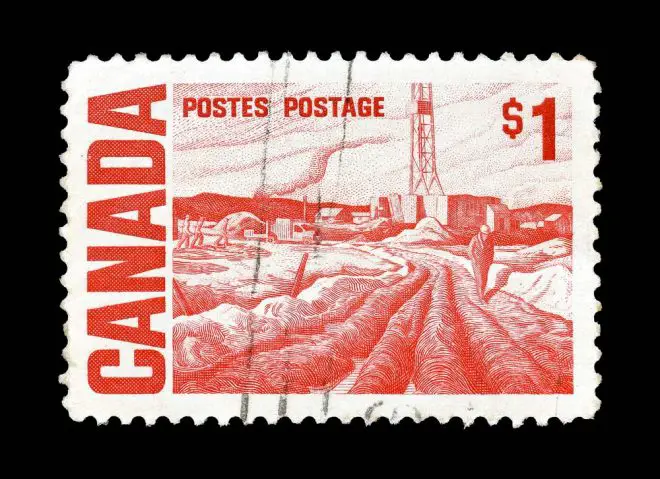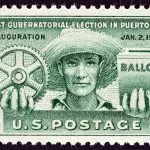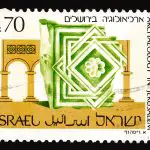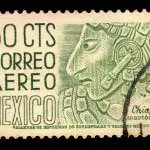
Shipping to Canada seems like it should be as easy as shipping within the continental United States; after all, it’s all part of the same landmass. However, shipments to Canada are considered international and are, therefore, subject to international shipping rates.
This article outlines the best carriers for shipments to Canada, unique shipping requirements, and the postage required for standard postcards, envelopes, and parcels.
Contents
Best Carriers for Mail to Canada
The United States Postal Service (USPS), Federal Express (FedEx), and the United Parcel Service (UPS) all ship to Canada.
For envelopes and light parcels, USPS is typically the most affordable carrier. USPS transports all envelopes and parcels to the border, where they give them to the Canada Post (the Canadian equivalent of USPS), who ultimately delivers them to their final destination.
USPS has a maximum parcel weight of 66 pounds when shipping to Canada. If you are shipping a parcel weighing more than 66 pounds, UPS tends to be the most affordable option.
If you need your parcel to arrive quickly or in a specific timeframe, FedEx is the best shipping option. FedEx offers definitive delivery days and has several shipping services that can guarantee delivery within a certain timeframe.
Given that USPS is the best option for the shipment of most letters, the postage rates in this article will reflect USPS prices (unless otherwise specified).
Postage to Send Postcards to Canada
Postcards can be shipped via USPS using international postage rates. To ship a postcard to Canada, you will need $1.30 in postage (per the August 29, 2021 price increase), which can be covered with one Global First Class Forever Stamp ($1.30) or three First Class Forever Stamps ($1.74).
USPS defines postcards as rectangular cards that have dimensions between 3.5×5.0x0.007 inches and 4.25×6.0x0.016 inches. Cards that are outside of these dimensions (or are not rectangular) require additional postage.
Postage to Send Standard Envelopes to Canada
Envelopes can be sent to Canada using international postage rates with USPS. To ship an envelope weighing less than three ounces to Canada, you will need $1.30 in postage (per the August 29, 2021 price increase), which can be covered with one Global First Class Forever Stamp ($1.30) or three First Class Forever Stamps ($1.74).
If your envelope weighs more than three ounces, you will need an additional $0.53 in postage for every additional ounce.
USPS defines standard envelopes as envelopes that have dimensions between 3.5×5.0x0.25 inches and 6.125×11.5×0.25 inches. If your envelope is rigid or not rectangular, your envelope will be considered non-machinable, meaning it will need to be hand-sorted. Non-machinable envelopes require an additional $0.21 in postage.
Postage to Send Large Envelopes to Canada
Large envelopes can be sent to Canada using international postage rates with USPS. USPS considers large envelopes to have dimensions between 6.125×11.5×0.25 inches and 12x15x0.75 inches.
The postage required to mail large envelopes is dependent on the weight of your envelope:
Weight |
Postage Required |
Stamps Required |
|
1.0 ounce |
$2.60 |
2 Global Forever Stamps ($2.60) or 5 First Class Forever Stamps ($2.90) |
|
2.0 ounces |
$2.85 |
3 Global Forever Stamp ($3.90) or 5 First Class Forever Stamps ($2.90) |
|
3.0 ounces |
$3.09 |
3 Global Forever Stamp ($3.90) or 6 First Class Forever Stamps ($3.48) |
|
4.0 ounces |
$3.31 |
3 Global Forever Stamp ($3.90) or 6 First Class Forever Stamps ($3.48) |
|
5.0 ounces |
$3.55 |
3 Global Forever Stamp ($3.90) or 7 First Class Forever Stamps ($4.06) |
|
6.0 ounces |
$3.79 |
3 Global Forever Stamp ($3.90) or 7 First Class Forever Stamps ($4.06) |
|
7.0 ounces |
$4.03 |
4 Global Forever Stamp ($5.20) or 7 First Class Forever Stamps ($4.06) |
|
8.0 ounces |
$4.27 |
4 Global Forever Stamp ($5.20) or 8 First Class Forever Stamps ($4.64) |
|
9.0 ounces |
$5.45 |
5 Global Forever Stamp ($6.50) or 10 First Class Forever Stamps ($5.80) |
|
10.0 ounces |
$5.45 |
5 Global Forever Stamp ($6.50) or 10 First Class Forever Stamps ($5.80) |
|
11.0 ounces |
$5.45 |
5 Global Forever Stamp ($6.50) or 10 First Class Forever Stamps ($5.80) |
|
12.0 ounces |
$5.45 |
5 Global Forever Stamp ($6.50) or 10 First Class Forever Stamps ($5.80) |
|
13.0 ounces |
$6.63 |
6 Global Forever Stamp ($7.80) or 12 First Class Forever Stamps ($6.96) |
Visit Where to Buy Stamps to find out where to buy stamps near you.
Postage to Send Packages to Canada
The postage required to send packages to Canada is based on the size and weight of the parcel. You can calculate the cost of postage for your parcel using the USPS Postage Price Calculator.
To use the USPS Postage Price Calculator, follow these steps:
- Follow the link to the USPS Postage Price Calculator.
- Under the “What’s the destination country” dropdown menu, select “Canada.”
- Enter the zip codes for your shipping location and destination. The USPS Postage Price Calculator has a convenient postal code identifier for Canadian municipalities and provinces if you do not know your destination postal code offhand.
- Enter the date and time of when you plan to ship your parcel.
- Select the type of parcel you wish to send.
- A new page will appear with the price of various shipping options in your area.
You can choose the shipping method of your choice based on your desired delivery date. Once you have determined the shipping method you wish to use, you can print a label using the USPS Click-N-Ship.
If you want to avoid the hassle of calculating your package’s size and weight, you can also ship items using USPS Flat Rate boxes. Flat Rate Boxes come in various sizes and can be shipped for a standard rate (regardless of the weight of the contents). For more information about the Flat Rate shipping options offered by USPS, visit USPS Priority Mail.
Delivery Times to Canada
The average delivery time for postcards and First Rate envelopes mailed with USPS First Class Mail International (the standard shipping option used) is 7-21 days. If you mail postcards or envelopes using Priority Mail International instead, the delivery time is shortened to 6-10 days. Priority Mail Express International is the most expensive option for postcards and letters, but it guarantees delivery in 3-5 days.
Package delivery times are dependent on the carrier and the shipping method you choose. Customs can also delay package delivery. Generally, parcels shipped with USPS, FedEx, and UPS take 2-7 days to reach their final destination.
Addressing Mail to Canada
Addresses in Canada are similar to those of the continental United States. Addresses should be completed in the following way:
Name of Addressee
Street Address
Municipality, Province, Postal Code
Country Name
Example:
John Smith
10-123 Main Street
Montreal, QC H3Z 2Y1
Canada
Additional information regarding each line of the address is discussed below:
Line 1: Name of Addressee
This line should reflect the name of the person or company to whom you are shipping.
Line 2: Street Address
When writing the street address, you want to write the unit or apartment number (if applicable), followed by the street number. The unit or apartment number and the street number should be separated by a hyphen, as seen in the example above.
Street directions and street types should be abbreviated following the same abbreviations used in the United States.
Line 3: Municipality, Province, Postal Code
The municipality, province, and postal code will follow the same format as the city, state, and ZIP code in the United States. Municipality names should be written out, and province names should be abbreviated. For a full list of province abbreviations, refer to the Canada Post Addressing Guidelines.
Canadian postal codes consist of a string of six letters and numbers that are split into two sets of three. They follow the format A1A 1A1, where A represents a letter, and 1 represents a number. When writing a Canadian postal code, the two sets of three should always be separated by a space, not a hyphen.
The first three digits of the Canadian postal code are known as the Forward Sortation Area (FSA) and represent the address’s geographical location. The next three digits are known as the Local Delivery Unit (LDU), which denotes a more specific area within the FSA.
Line 4: Country Name
This line represents the country in which your parcel’s final destination is located (in this case, you will want to write “Canada”).
Customs Forms for Shipments to Canada
Parcels shipped to Canada require customs forms. Packages that enter Canada are screened by the Canadian Border Services Agency (CBSA). Any package over $20 CAD can be searched and given an additional handling fee.
If you are shipping with USPS, the customs declarations are incorporated into the label on your parcel, and no additional documentation is required. If you are shipping with UPS, you can complete your customs forms using the UPS Electronic Data Interchange (EDI). If you are shipping with FedEx, you can complete your customs forms using the FedEx Electronic Trade Documents (ETD).
If you are concerned about your customs forms or unsure how to fill them out, employees at USPS, FedEx, and UPS will happily help you complete the forms and prepare your package for shipment.
Items Prohibited from Import to Canada
Each country has its own set of rules regarding items that are prohibited for import or export. Being able to ship an item from the United States does not guarantee that the item will pass through customs and into your destination country. Therefore, it is important to make sure that the items you are shipping are not included on the Canadian prohibited item list.
Some of the most common items that are not allowed to be shipped to Canada include:
- Live animals (with several exceptions, including bees, parasites, leeches, hatchlings, and some small cold-blooded animals)
- Tobacco items in any form, including cigarettes, cigars, chewing tobacco, and e-cigarettes)
- Specific plant species
- Currency
- Lottery tickets or any other gambling-related items
For a full list of Canada’s import prohibitions and restrictions, see FedEx’s Canada Prohibited and Restricted Items list.
For additional information regarding shipments within the United States and internationally, check out postage and shipping information on mystampguide.com.






